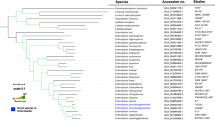Abstract
The name Enterobacter kobei sp. nov. is proposed for a group of organisms referred to as NIH Group 21 at the National Institute of Health, Tokyo. The members of this species are Gram-negative, motile rods conforming to the definition of the family Enterobacteriaceae. The DNA relatedness of 23 strains of NIH Group 21 to the representative proposed as the type strain of this species averaged 82% at 70°C, whereas the relatedness to other species within the family Enterobacteriaceae was less than 42%. Because the phenotypic resemblance to Enterobacter cloacae is very close and the DNA relatedness (12–42%) is closer to species of the genus Enterobacter than to other species of the family, the members of NIH Group 21 were placed in the genus Enterobacter. Close phenotypic and genetic relationships were also found between NIH Group 21 and a member of a group of organisms referred to as Enteric Group 69 at the Centers for Disease Control and Prevention (CDC), Atlanta, Georgia, USA. It is suggested that the latter could be regarded as a subspecific rank of E. kobei, though this is subject to study of further strains. The majority of strains of E. kobei were isolated from clinical specimens. A culture of the type strain (NIH 1485-79) has been deposited in the Japan Collection of Microorganisms as JCM 8580.
Similar content being viewed by others
Literature Cited
Cowan ST (1974) Cowan and Steel’s Manual for the identification of medical bacteria, 2nd ed. London: Cambridge Univ. Press
Ewing WH (1986) Edwards and Ewing’s Identification of Enterobacteriaceae, 4th ed. New York: Elsevier
Farmer JJ (1994) Enterobacteriaceae. In: Murray PR, Baron EJ, Pfaller MA, Tenover FC, Yolken RH (eds), Manual of clinical microbiology, 6th ed. Washington, D.C.: American Society for Microbiology, pp 438–449
Moller V (1954) Distribution of amino acid decarboxylases in Enterobacteriaceae. Acta Pathol Microbiol Scand 35: 259–277
Owen RJ, Hill LR, Lapage SP (1969) Determination of DNA base composition from melting profiles in dilute buffers. Biopolymers 7: 503–516
Sakazaki R, Namioka S (1957) Biochemical studies on Voges-Proskauer positive enteric bacteria. Jpn J Exp Med 27: 273–282
Sakazaki R, Tamura K, Kosako Y, Yoshizaki E (1989) Klebsiella ornithinolytica sp. nov., formerly known as ornithine-positive Klebsiella oxytoca. Curr Microbiol 18: 201–206
Author information
Authors and Affiliations
Rights and permissions
About this article
Cite this article
Kosako, Y., Tamura, K., Sakazaki, R. et al. Enterobacter kobei sp. nov., a new species of the family Enterobacteriaceae resembling Enterobacter cloacae . Current Microbiology 33, 261–265 (1996). https://doi.org/10.1007/s002849900110
Received:
Accepted:
Issue Date:
DOI: https://doi.org/10.1007/s002849900110




